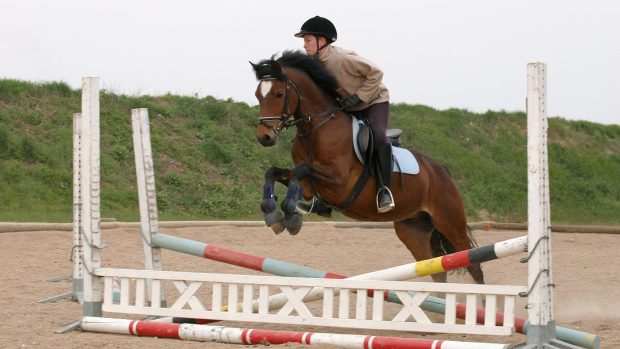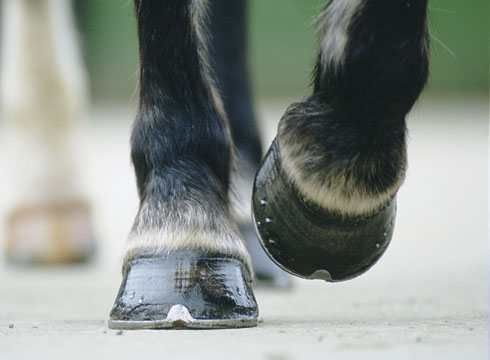The show ring has a strict no blemishes or conformation faults policy for a horse to stand at the top of the line. But which issues can potentially compromise a horse’s physical health and which can you afford you look past?
1. Over-straight hindleg
A hindleg with insufficient angulation between the femur and tibia can be classed as “over-straight”, can limit the horse’s movement and cause problems in the stifle and hock joints and elsewhere, including the suspensory ligaments and patella. Over-straight hindlegs are pre-disposed to injury, so send alarm bells ringing for vets.
“Even if the horse trots soundly at the vetting and passes the flexion tests, conformation issues such as an over-straight hindleg make you worry about the horse’s soundness going forward,” says Lindsay Brazil MRCVS of Cheltenham Equine Vets.
2. Splints
Although not always the case, splints are sometimes caused by poor limb conformation.
“Splints are usually a result of a pre-existing angular or rotational limb deformity, which themselves pre-dispose to an imbalance in the feet,” says Dr Jane Nixon MRCVS of Nixon Equine Vet Consultancy.
Certain forelimb conformations that cause higher stresses down the inside or outside of the limb, such as offset knees or pigeon toes, may also lead to splints.
“Depending on how long they have been there, splints can cause problems but, if they have been present for a long time and are inactive, they don’t generally cause issues with soundness,” says Shirley Seed MRCVS from Oaklands Equine Hospital.
Splints are no good on a show horse, which is why owners and riders spend considerable time and money trying to prevent them.
“Splints are considered a blemish on a show horse and you want him to be as clean-limbed as possible. If you have to choose between a horse with clean limbs and a horse with splints, you are always going to choose the clean-legged one,” says showing judge Joanna MacInnes.
3. Upright pasterns
The hoof-pastern axis is an important conformational feature to consider. If the angle of the pastern is too upright, the horse can be prone to concussion as the shock is not dispersed by the tendons but, instead, is transmitted upwards through the bones. As well as being widely associated with navicular syndrome and arthritis, upright pasterns do not make for a comfortable ride.
“A horse with upright pasterns, which go with an upright shoulder, will have a shorter and choppier stride, so is likely to be a more jarring ride than one with a sloping pastern, and will be marked down in the show ring,” says Joanna.
Showing producer and event rider Richard Telford agrees: “Upright pasterns always give a jarring ride and you wouldn’t want to event a horse with them, especially on hard ground. Sloping pasterns behind are also a real weakness and will only lead to trouble.”
4. Hoof conformation
All stresses in the limbs go through the feet, so it is imperative that the hooves are well-balanced, the correct shape and have excellent horn quality.
“Hind foot balance is most important as the hind feet are joined at the spine by the hips and the sacroiliac joint. Any asymmetry between the two back feet will be magnified up the hind leg and into the spine. The left and right side become dissimilar, which can cause issues such as hindleg lameness, back problems and difficulties with the fit of the saddle,” says Jane.
“If the horse’s toe turns out, particularly on one foot more than the other, then excessive loading of the inside limb occurs, which is very serious and difficult to correct. It can be remedied if it is managed from day one but, if it is left, it can cause big problems.”
5. Long or short neck
“A long or short neck may affect the way the horse rides but it will not affect his soundness and, unless it is abnormally short or long, it isn’t a problem for me,” says Joanna.
Lindsay agrees: “The length of neck doesn’t worry me. However, if the horse had a ewe neck having built up muscle in the wrong places with a poorly developed neck topline, I would be asking why it is like that and paying particular attention to the way that it moves and how it has been trained.”
From a riding perspective, however, short necks are often undesirable: “A horse with a short neck and an upright shoulder is quite an uncomfortable ride; it is like sitting on a cliff edge,” says Richard Telford. “Similarly, I wouldn’t pick a horse that is croup high and lower in front as you will have a never-ending battle trying to get it up in front.”
6. Scars
Although scarring can be an inevitable result of a wound, it is still undesirable in the show ring due to its stringent no-blemish policy.
“In a perfect world you want the horse to have as good conformation as possible without scrapes, lumps and bumps, but it’s very difficult to keep a horse clean limbed,” says Joanna.
Shirley Seed continues: “Once healed, a scar should not compromise a horse’s performance, unless it’s restricting movement or is something such as an old overreach injury that might reoccur. I would class scars as cosmetic faults.”
7. Sickle hocks
These are a severe hindleg defect that occurs when the lower legs appear to curve underneath the horse, consequently pushing the hoof too far forward and placing enormous strain on the hocks. This conformation fault can also lead to horses developing curbs (thickening of a ligament in the hock that causes visible swelling).
“A horse with sickle or ‘cow hocks’ is best avoided, although sometimes a horse with sickle hocks can actually have really active hind legs,” says Richard. “You will always get horses that go against the grain, like my old two-star event horse, Dilemma II, who had curbs on both her hindlegs. She was a good jumper and really successful, yet you would never accept a show horse with curbs.”
- To stay up to date with all the breaking news throughout London International and more, subscribe to the Horse & Hound website
You may also be interested in:

4 common eye problems in horses and how to treat them
Stay on the look out for these common eye problems in horses

6 common hoof problems to keep an eye out for

Subscribe to Horse & Hound magazine today – and enjoy unlimited website access all year round




